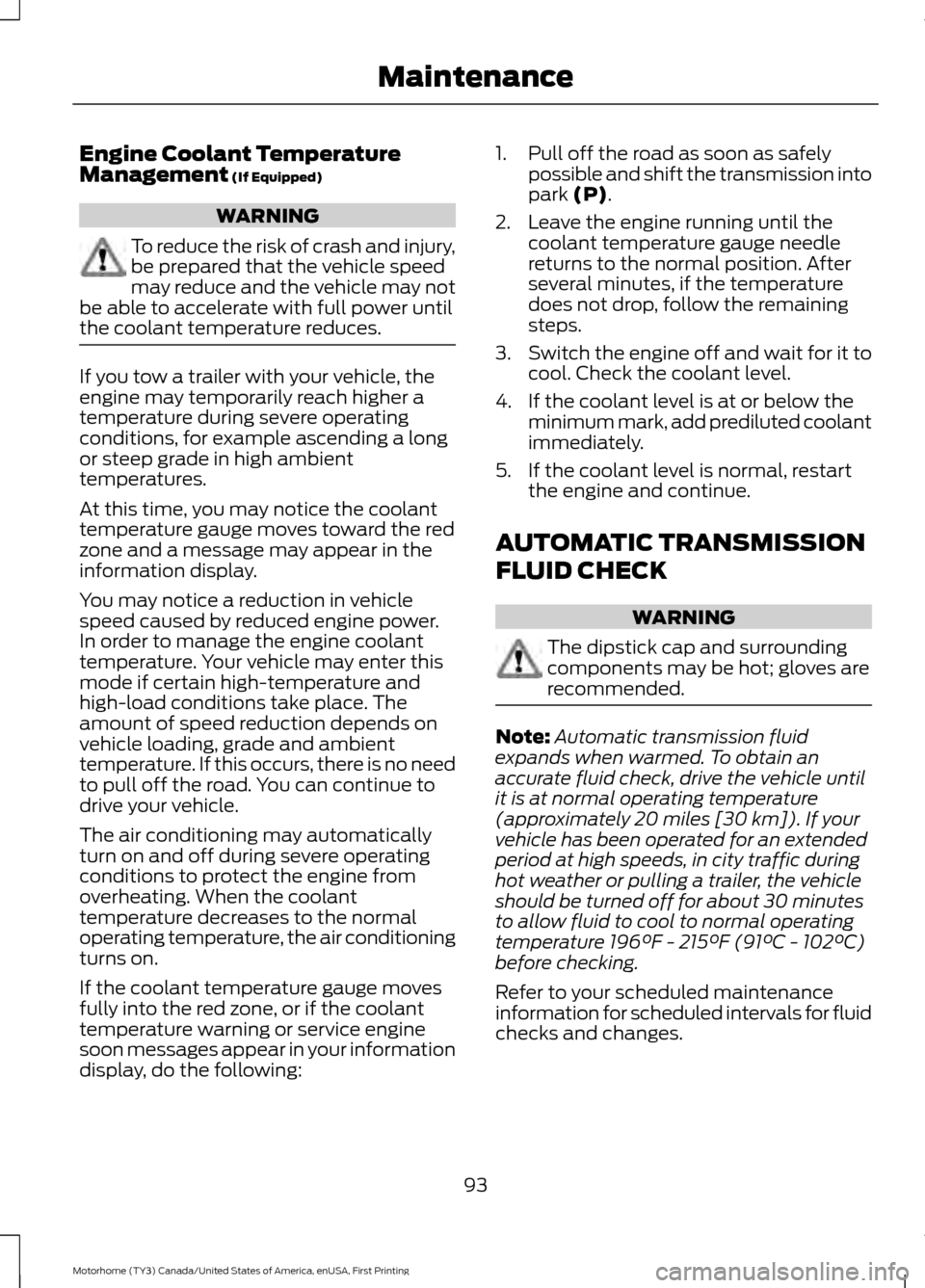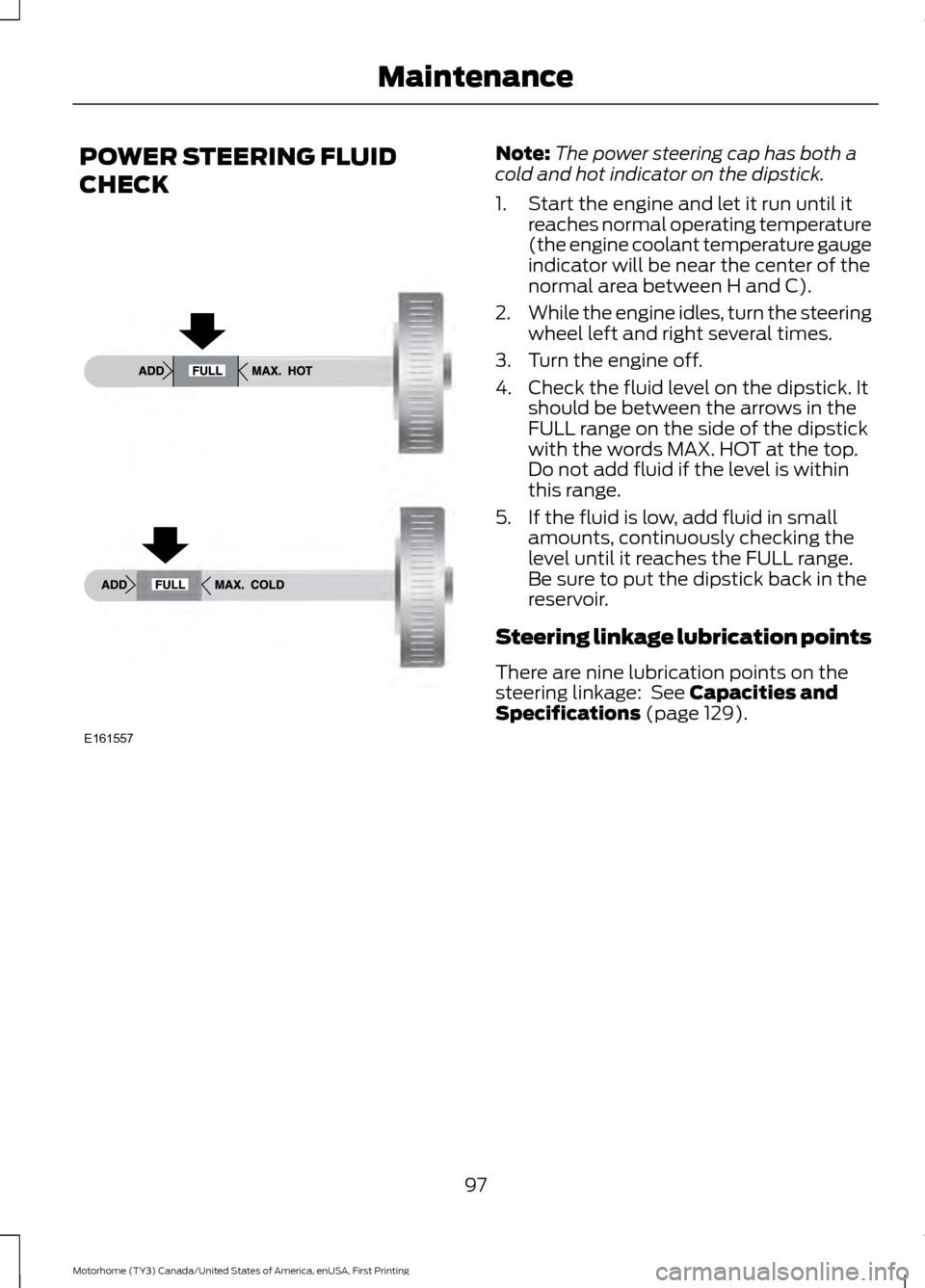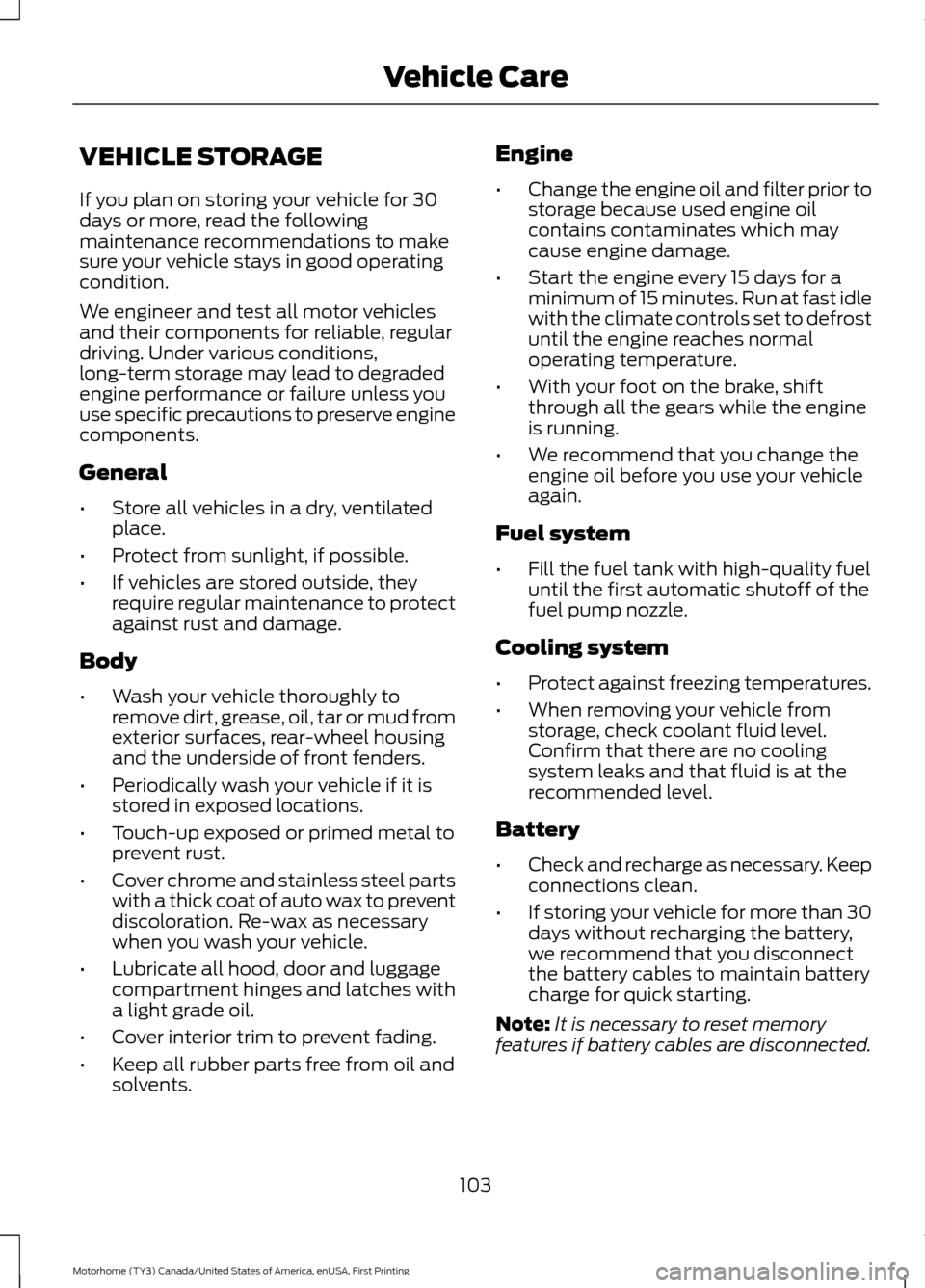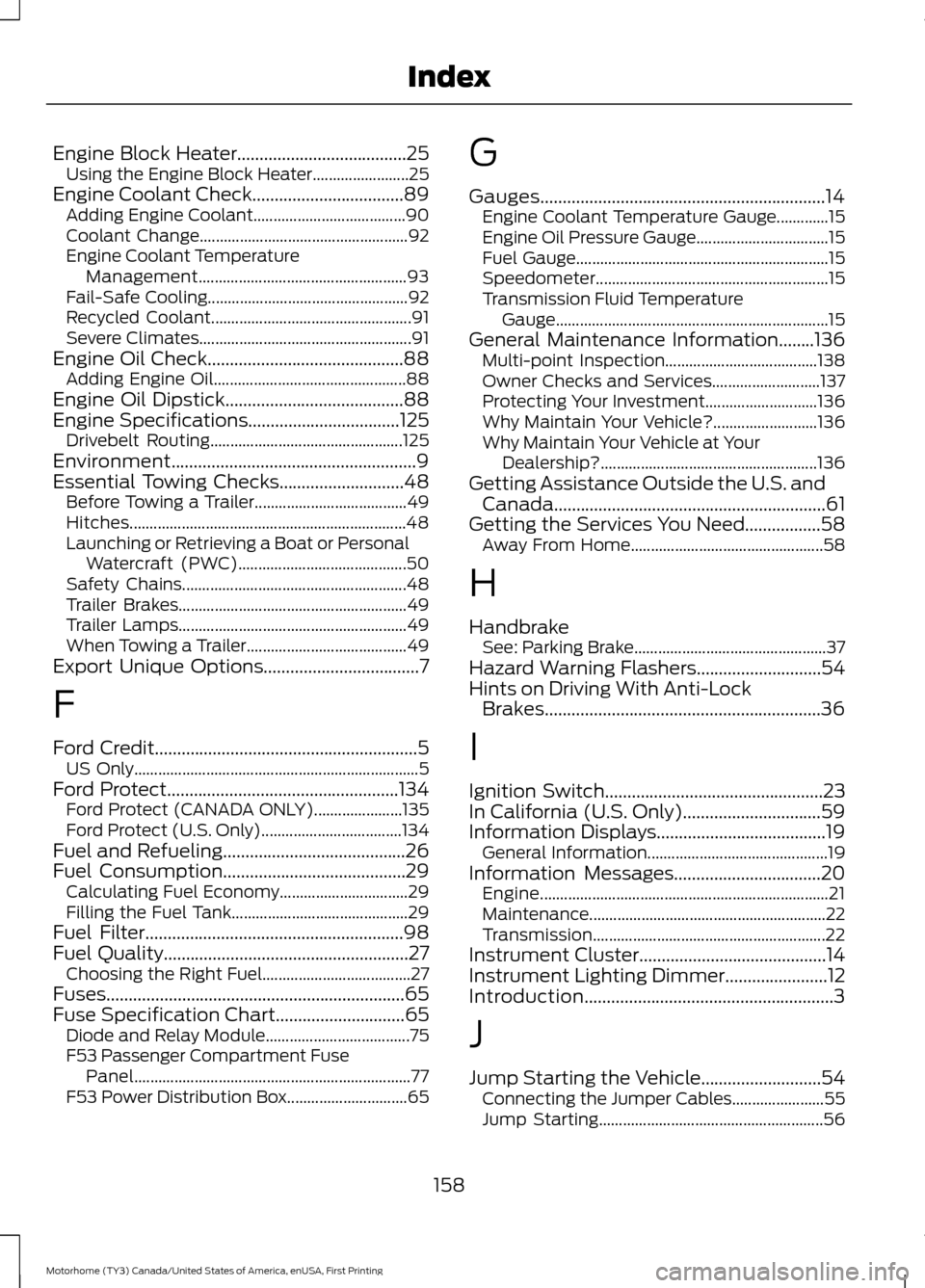2017 FORD F SERIES MOTORHOME AND COMMERCIAL CHASSIS coolant temperature
[x] Cancel search: coolant temperaturePage 96 of 164

Engine Coolant Temperature
Management (If Equipped)
WARNING
To reduce the risk of crash and injury,
be prepared that the vehicle speed
may reduce and the vehicle may not
be able to accelerate with full power until
the coolant temperature reduces. If you tow a trailer with your vehicle, the
engine may temporarily reach higher a
temperature during severe operating
conditions, for example ascending a long
or steep grade in high ambient
temperatures.
At this time, you may notice the coolant
temperature gauge moves toward the red
zone and a message may appear in the
information display.
You may notice a reduction in vehicle
speed caused by reduced engine power.
In order to manage the engine coolant
temperature. Your vehicle may enter this
mode if certain high-temperature and
high-load conditions take place. The
amount of speed reduction depends on
vehicle loading, grade and ambient
temperature. If this occurs, there is no need
to pull off the road. You can continue to
drive your vehicle.
The air conditioning may automatically
turn on and off during severe operating
conditions to protect the engine from
overheating. When the coolant
temperature decreases to the normal
operating temperature, the air conditioning
turns on.
If the coolant temperature gauge moves
fully into the red zone, or if the coolant
temperature warning or service engine
soon messages appear in your information
display, do the following: 1. Pull off the road as soon as safely
possible and shift the transmission into
park (P).
2. Leave the engine running until the coolant temperature gauge needle
returns to the normal position. After
several minutes, if the temperature
does not drop, follow the remaining
steps.
3. Switch the engine off and wait for it to
cool. Check the coolant level.
4. If the coolant level is at or below the minimum mark, add prediluted coolant
immediately.
5. If the coolant level is normal, restart the engine and continue.
AUTOMATIC TRANSMISSION
FLUID CHECK WARNING
The dipstick cap and surrounding
components may be hot; gloves are
recommended.
Note:
Automatic transmission fluid
expands when warmed. To obtain an
accurate fluid check, drive the vehicle until
it is at normal operating temperature
(approximately 20 miles [30 km]). If your
vehicle has been operated for an extended
period at high speeds, in city traffic during
hot weather or pulling a trailer, the vehicle
should be turned off for about 30 minutes
to allow fluid to cool to normal operating
temperature 196°F - 215°F (91°C - 102°C)
before checking.
Refer to your scheduled maintenance
information for scheduled intervals for fluid
checks and changes.
93
Motorhome (TY3) Canada/United States of America, enUSA, First Printing Maintenance
Page 100 of 164

POWER STEERING FLUID
CHECK Note:
The power steering cap has both a
cold and hot indicator on the dipstick.
1. Start the engine and let it run until it reaches normal operating temperature
(the engine coolant temperature gauge
indicator will be near the center of the
normal area between H and C).
2. While the engine idles, turn the steering
wheel left and right several times.
3. Turn the engine off.
4. Check the fluid level on the dipstick. It should be between the arrows in the
FULL range on the side of the dipstick
with the words MAX. HOT at the top.
Do not add fluid if the level is within
this range.
5. If the fluid is low, add fluid in small amounts, continuously checking the
level until it reaches the FULL range.
Be sure to put the dipstick back in the
reservoir.
Steering linkage lubrication points
There are nine lubrication points on the
steering linkage: See Capacities and
Specifications (page 129).
97
Motorhome (TY3) Canada/United States of America, enUSA, First Printing MaintenanceE161557
Page 106 of 164

VEHICLE STORAGE
If you plan on storing your vehicle for 30
days or more, read the following
maintenance recommendations to make
sure your vehicle stays in good operating
condition.
We engineer and test all motor vehicles
and their components for reliable, regular
driving. Under various conditions,
long-term storage may lead to degraded
engine performance or failure unless you
use specific precautions to preserve engine
components.
General
•
Store all vehicles in a dry, ventilated
place.
• Protect from sunlight, if possible.
• If vehicles are stored outside, they
require regular maintenance to protect
against rust and damage.
Body
• Wash your vehicle thoroughly to
remove dirt, grease, oil, tar or mud from
exterior surfaces, rear-wheel housing
and the underside of front fenders.
• Periodically wash your vehicle if it is
stored in exposed locations.
• Touch-up exposed or primed metal to
prevent rust.
• Cover chrome and stainless steel parts
with a thick coat of auto wax to prevent
discoloration. Re-wax as necessary
when you wash your vehicle.
• Lubricate all hood, door and luggage
compartment hinges and latches with
a light grade oil.
• Cover interior trim to prevent fading.
• Keep all rubber parts free from oil and
solvents. Engine
•
Change the engine oil and filter prior to
storage because used engine oil
contains contaminates which may
cause engine damage.
• Start the engine every 15 days for a
minimum of 15 minutes. Run at fast idle
with the climate controls set to defrost
until the engine reaches normal
operating temperature.
• With your foot on the brake, shift
through all the gears while the engine
is running.
• We recommend that you change the
engine oil before you use your vehicle
again.
Fuel system
• Fill the fuel tank with high-quality fuel
until the first automatic shutoff of the
fuel pump nozzle.
Cooling system
• Protect against freezing temperatures.
• When removing your vehicle from
storage, check coolant fluid level.
Confirm that there are no cooling
system leaks and that fluid is at the
recommended level.
Battery
• Check and recharge as necessary. Keep
connections clean.
• If storing your vehicle for more than 30
days without recharging the battery,
we recommend that you disconnect
the battery cables to maintain battery
charge for quick starting.
Note: It is necessary to reset memory
features if battery cables are disconnected.
103
Motorhome (TY3) Canada/United States of America, enUSA, First Printing Vehicle Care
Page 161 of 164

Engine Block Heater......................................25
Using the Engine Block Heater........................ 25
Engine Coolant Check..................................89
Adding Engine Coolant...................................... 90
Coolant Change.................................................... 92
Engine Coolant Temperature Management.................................................... 93
Fail-Safe Cooling.................................................. 92
Recycled Coolant.................................................. 91
Severe Climates..................................................... 91
Engine Oil Check............................................88 Adding Engine Oil................................................ 88
Engine Oil Dipstick
........................................88
Engine Specifications..................................125
Drivebelt Routing................................................ 125
Environment.......................................................9
Essential Towing Checks............................48 Before Towing a Trailer...................................... 49
Hitches..................................................................... 48
Launching or Retrieving a Boat or Personal Watercraft (PWC).......................................... 50
Safety Chains........................................................ 48
Trailer Brakes......................................................... 49
Trailer Lamps......................................................... 49
When Towing a Trailer........................................ 49
Export Unique Options
...................................7
F
Ford Credit...........................................................5 US Only....................................................................... 5
Ford Protect....................................................134 Ford Protect (CANADA ONLY)...................... 135
Ford Protect (U.S. Only)................................... 134
Fuel and Refueling.........................................26
Fuel Consumption
.........................................29
Calculating Fuel Economy................................ 29
Filling the Fuel Tank............................................ 29
Fuel Filter
..........................................................98
Fuel Quality.......................................................27
Choosing the Right Fuel..................................... 27
Fuses...................................................................65
Fuse Specification Chart
.............................65
Diode and Relay Module.................................... 75
F53 Passenger Compartment Fuse Panel..................................................................... 77
F53 Power Distribution Box.............................. 65G
Gauges
................................................................14
Engine Coolant Temperature Gauge.............15
Engine Oil Pressure Gauge................................. 15
Fuel Gauge............................................................... 15
Speedometer.......................................................... 15
Transmission Fluid Temperature Gauge.................................................................... 15
General Maintenance Information
........136
Multi-point Inspection...................................... 138
Owner Checks and Services........................... 137
Protecting Your Investment............................ 136
Why Maintain Your Vehicle?.......................... 136
Why Maintain Your Vehicle at Your Dealership?...................................................... 136
Getting Assistance Outside the U.S. and Canada.............................................................61
Getting the Services You Need
.................58
Away From Home................................................ 58
H
Handbrake See: Parking Brake................................................ 37
Hazard Warning Flashers............................54
Hints on Driving With Anti-Lock Brakes..............................................................36
I
Ignition Switch
.................................................23
In California (U.S. Only)...............................59
Information Displays
......................................19
General Information............................................. 19
Information Messages
.................................20
Engine........................................................................\
21
Maintenance........................................................... 22
Transmission.......................................................... 22
Instrument Cluster
..........................................14
Instrument Lighting Dimmer.......................12
Introduction........................................................3
J
Jump Starting the Vehicle...........................54 Connecting the Jumper Cables....................... 55
Jump Starting........................................................ 56
158
Motorhome (TY3) Canada/United States of America, enUSA, First Printing Index